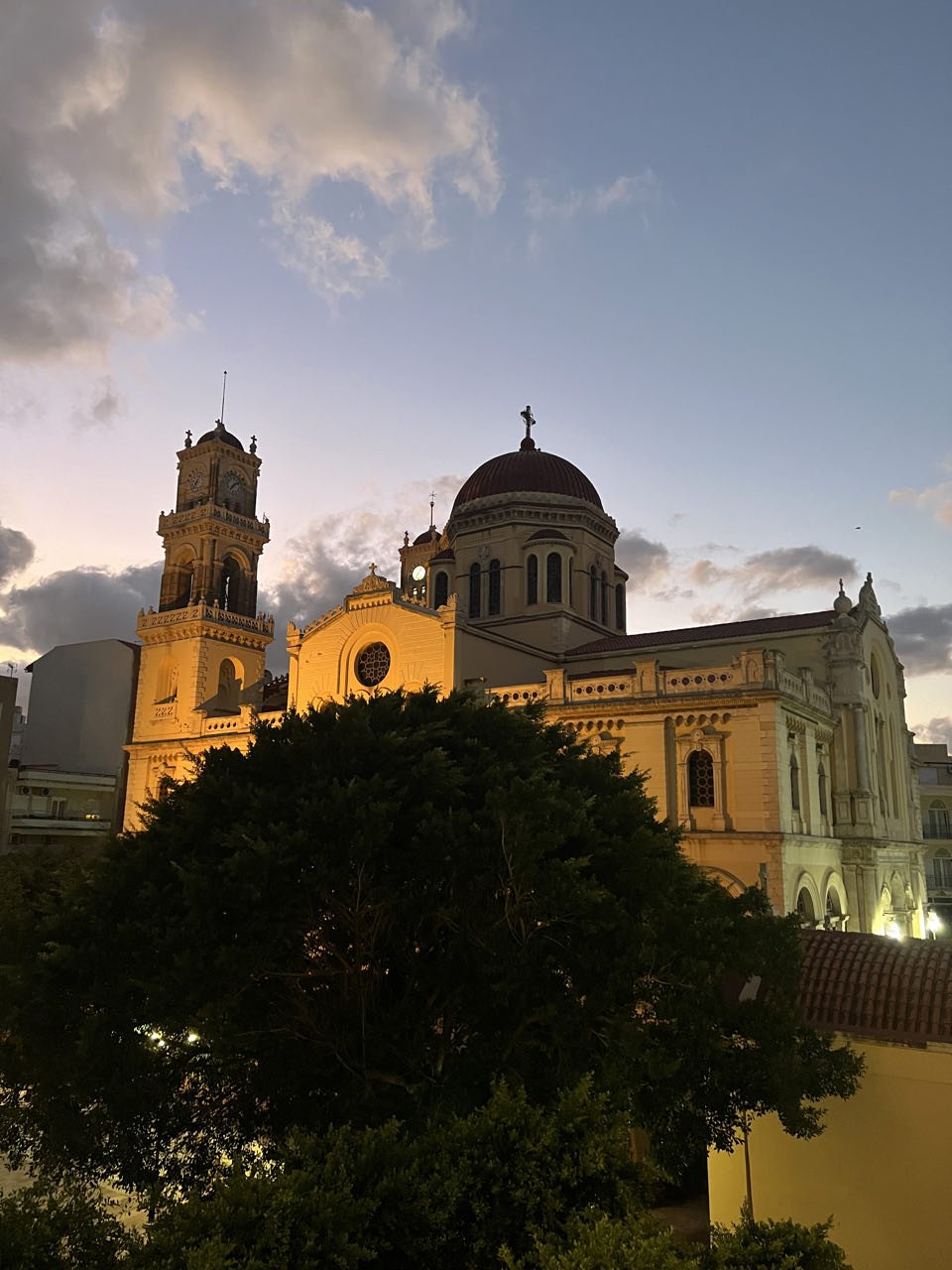Days 702 - 706 - Heraklion, Crete
Arrival at the Port of Piraeus
Cathedral of Agios Minas at Dawn
It was 10 o’clock whenever we dragged our bags over to the Port of Piraeus in Athens to board our ferry to Crete. The harbor was crazy with cars and trucks and people and motorcycles traveling in every direction as we worked our way to the giant ferry. Finally, we settled in and were soon asleep in our cabin.
Eight hours later we awakened, still in the dark, but at the ancient port of Heraklion. From there a cab took us to our hotel at the Metropole Urban very close by and right next to the famous Cathedral of Saint Catherine. There we settled in for a nice breakfast.
Later, we visited the immense and impressive Heraklion Museum, home to some of the most ancient examples of the Minoan Empire’s art, architecture, even its famous bull leaping games. The famous Greek myth of the Minotaur and the Labyrinth were inspired by Knossos, the massive palace that was created by the Minoans 4000 years ago. Later we would walk to visit Knossos, or what remains of it, but for now we spent the afternoon walking through time and taking a gander at three busts of the most famous Roman emperors of all time: Mark Aurelius, Julius Caesar and Augustus Cesar.
Exploring the Palace of Knossos
Over the next couple of days we explored Heraklion.
We also walked to the famous Palace of Knossos, inspiration for the myth of the Minotaur and the Labyrinth. Along the way, we saw the great Venetian Wall that once protected the city when it was built in the 15th century, and saw the museum of Nikolas Kazantzakis, one of my favorite writers and Greece’s most esteemed modern author.
We later walked up to his burial ground, which is built on top of one of the Venetian Walls near a place called Jesus Gate, which is fitting since one of Kazantzakis’s most famous books is The Last Temptation of Christ. He also wrote a sequel to Homer’s Odyssey and perhaps his most famous book Zorba the Greek.
It was a long walk to the Palace of Knossos so before we explored it, we stopped at a wonderful restaurant just outside the ruins called Pasiphae. Delicious. If you’re in the area, be sure to try them out.
For the price of a few dollars you can walk right into the Palace of Knossos and be gotslopped, because you are walking through an example of one of the most advanced civilizations of antiquity. A gargantuan palace built by the Minoan people with remarkably advanced culture, science and technology. 4000 years ago they had flush toilets. And they basically were the foundation of the great Greek city-states like Athens, Corinth and Sparta that emerged later on the mainland of Greece. I’ve posted several videos as we walked those grounds to give you an idea of what an amazing place and culture this was.
Heraklion and back to Athens
Our last two days in Heraklion kept us busy. And we were fine with that. We wanted to make sure to explore the Venetian Wall, which has been renovated along portions of the old city and deliver great views of the sea, and the charming old town. That also took us to the grave of Nikos Kazanzakis, the author of Zorba the Greek and The Last Temptation of Christ. Personally, when I was in high school, reading that book changed my life.
We also hiked down to the beaches near the city. They are beautiful, but Crete, which is over 200 miles long, has some of the most beautiful beaches in the world. And I’ll be sure to write about those in the future. While we were walking on the beach we caught windsurfers skating along the water at high speed, and saw some fascinating sculptures, like this take on Venus de Milo and the ubiquitous plastic bottles that are plaguing the entire planet.
After that we had to be sure to find a famous restaurant called Phyllosophies, located right in front of the Morozini Fountain built in 1629, famous for its four sculptured lions. It is also basically the town Square. This restaurant is famous for its bougatsa, which is a delicious phyllo pastry made with a kind of pudding and light Grecian cheese whipped and stuffed between the phyllo. Absolutely delicious.
Before heading back on our last day to prepare taking the night ferry back to Athens, we peeked inside beautiful Saint Catherine’s church right outside the Metropole Urban Hotel where we had been staying for the last few days. I had taken dozens of pictures of the church in different light but found the inside of the church was just as beautiful.
Finally at 9 PM, we clicked and clacked down to the harbor, boarded our ship, and sadly said goodbye to this beautiful island and the charming city names for Hercules. If you are planning a trip to the Mediterranean, you should be sure to visit it. But we recommend you do it between late September and early November, when the tourists aren’t quite so many and the weather is still perfect.
Recommendations
If you’re setting out for the Balkans and Adriatic Regions of Europe, please consider some of these recommendations.





































A great place located just next to Split’s Old Town with walking access to Croatia’s unique heritage, including Diocletian’s Palace and St. Domnius Cathedral. Visitors will also find excellent shopping and dining nearby.